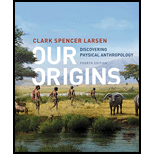
Concept explainers
Introduction: In taxonomical order, primate members belong to animal groups. They are different from mammals and found all over the world. They have a unique combination of traits. The dental pattern of primates are different from others. They possess forward-facing eyes and grasping hands and feet.
Answer to Problem 1SQ
Correct answer: c.
Explanation of Solution
Reason for the correct answer:
According to the angiosperm radiation hypothesis, the availability of fruits and flowers are acquired by primates with the help of visual acuity and grasping hands. This is because of the spread of angiosperms in the early Cenozoic. Thus, this hypothesis specifically linked with the evolution of primates.
Option c. is given as “angiosperm radiation hypothesis”.
Hence, the correct answer is option c.
Reasons for incorrect answers:
Option a. is given as “arboreal hypothesis”.
The arboreal hypothesis explains the evolution of primates based on their unique adaption to living on trees. Therefore, option a is incorrect.
Option b. is given as “visual predation hypothesis”.
This hypothesis reveals the characters of primates are an adaptation to prey on small insects and animals. Therefore, option b. is incorrect.
Option d. is given as “gymnosperm radiation hypothesis”.
There is no gymnosperm radiation hypothesis that exists for the evolution of primates. Therefore, option d. is incorrect.
Hence, options a., b., and d. are incorrect.
Thus, the angiosperm radiation hypothesis specifically links the evolution of primates.
Want to see more full solutions like this?
Chapter 9 Solutions
Our Origins: Discovering Physical Anthropology (Fourth Edition)
- A diploid, multicellular life-cycle stage that gives rise to haploid cells by meiosis is called a ________. a. sporophyte b. gametophyte c. spore d. gametearrow_forwardThe production of megaphylls by many different species of plants is an example of _____. a. parallel evolution b. analogy c. divergent evolution d. homologyarrow_forwardthe same as the genus of an animal that steals chloroplasts from algae. It can keep the chloroplasts alive for many months, thanks to genes that were originally part of the algae genome. What kind of animal is this? A. Luna both caterpillars, Insecta, Arthropod B. Marine Flatworm, platyhelminthes C. Sea slug, mollusk gastropod D. Bivalve, Mollusk 18arrow_forward
- Protists with the capabilities to absorb nutrients from dead organisms are called_____________. a. photoautotrophs b. autotrophs c. saprobes d. heterotrophsarrow_forwardDuring the ____________________ phase of microbial population growth, the rate of cell division begins to slow down or division stops entirely. a. stationary b. lag c. death d. exponental growtharrow_forwardQUESTION 22 Select the feature that MOST CLOSELY applies to each of the statements below regarding the evolution of life on land. Each term may be used once or not at all. + Helps plants withstand the effects of gravity. a, foramen magnum + Aids with distributing water and nutrients throughout the plant body. b. pollen * Allows the male gametes of plants to reach female gametes in the c. flowers absence of water. d. amniotic egg + Helps animal embryos survive even under the driest conditions. e. lignin + Helps plants avoid desiccation. f. wings g. vascular tissue h. leaves i. waxy cuticlearrow_forward
- If two mouse populations do not interbreed but are found in the same area, they may form different species due to d. Adaptive radiation c. Spontaneous generation a. Geographic isolation b. Mutations OOOOarrow_forwardOrganisms most likely to be found in extreme environments are ________. a. fungi b. bacteria c. viruses d. archaeaarrow_forward1)Darwin recognized tortoises having different neck lengths on the different islands of the Galápagos because ____. * A. Some needed to see above rocks for predators and some did not B. Some females preferred long necks, and other females preferred short necks C. Some swam in their environment and some did not D. The abiotic factors caused different types of plants in which tortoises had to adapt to eating themarrow_forward
- The Cactus plant family and the Euphorb plant family independently evolved large, water-storing, photosynthetic stems in response to desert conditions, despite being in very distantly related evolutionarily lineages. What is this an example of? A. Evolutionary reversal B. Divergent evolution C. Convergent evolution D. Homology E. C and Darrow_forward27. Which term describes any ancient remains, impressions, or traces of an organism or traces of its activity that have been preserved in rocks or other mineral deposits in Earth's crust? a. analogous feature b. homologous feature c. mutation d. fossiarrow_forwardchoose the combination of answers that most accurately completes the statement.Mitochondria likely originated from a. archaea b. invaginations of the cell membrane c. rickettsias d. cyanobacteriaarrow_forward
